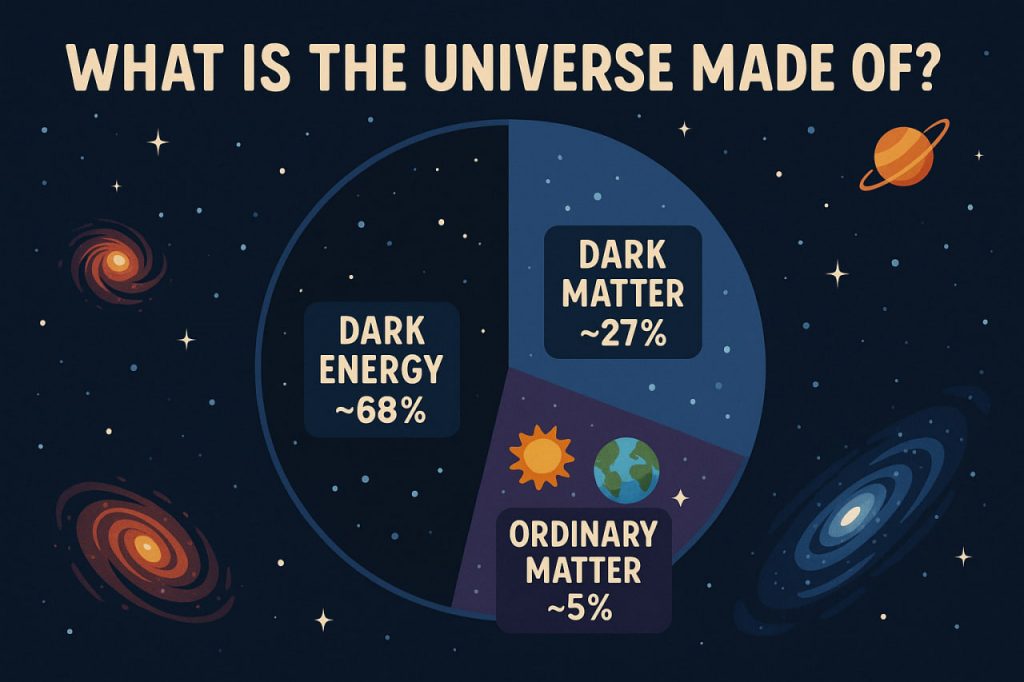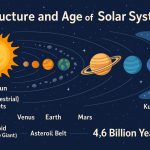The universe is vast, mysterious, and full of wonders—from stars and planets to invisible forces we can barely comprehend. But what exactly is it made of? Modern astrophysics tells us that the visible matter we see—galaxies, stars, and planets—makes up only a small fraction of everything that exists. Most of the universe is composed of unseen, exotic substances that scientists are still working to understand.
The Three Main Components of the Universe
1. Ordinary Matter (≈ 5%)
This is the type of matter we interact with every day. Also known as baryonic matter, it includes:
- Atoms (protons, neutrons, electrons)
- Stars, planets, gas, and dust
- People, animals, water, air—everything visible
Despite being all around us, this matter makes up only 5% of the universe.
2. Dark Matter (≈ 27%)
Dark matter is invisible—it doesn’t emit, absorb, or reflect light, making it undetectable with regular telescopes. However, its presence is known because of its gravitational effects on galaxies and galaxy clusters.
- It helps galaxies stay together—without it, they would fly apart
- Scientists believe it might be made of particles like WIMPs (Weakly Interacting Massive Particles), though none have been directly detected
Dark matter acts like an invisible glue that holds much of the universe’s structure together.
3. Dark Energy (≈ 68%)
Even more mysterious than dark matter, dark energy is a force that appears to be pushing the universe apart. It’s responsible for the observed acceleration in the expansion of the universe.
- First discovered in the 1990s through supernova observations
- Thought to be evenly distributed throughout space
- Makes up the majority of the universe’s total energy content
Scientists don’t know exactly what dark energy is, but it seems to oppose gravity and is the driving force behind cosmic expansion.
Other Components Worth Mentioning
- Neutrinos: Tiny, nearly massless particles that pass through matter with almost no interaction.
- Radiation: Light, cosmic microwave background (CMB), and other electromagnetic waves leftover from the Big Bang.
- Gravitational Waves: Ripples in spacetime caused by massive cosmic events like black hole collisions.
The Cosmic Recipe (According to Current Science)
- Dark Energy – ~68%
- Dark Matter – ~27%
- Ordinary Matter – ~5%
This breakdown was confirmed by detailed measurements of the Cosmic Microwave Background and large-scale galaxy surveys.
Why This Matters
Understanding what the universe is made of helps scientists answer fundamental questions:
- How did the universe begin?
- What is its ultimate fate?
- What are the basic building blocks of nature?
This ongoing exploration blends astronomy, physics, and cosmology to expand the limits of human knowledge.
Conclusion
Most of the universe is invisible and unknown. While we live among stars and galaxies made of ordinary matter, they are just a small part of a much larger and stranger cosmic picture. Thanks to space telescopes and theoretical physics, we are gradually unveiling the deep secrets of what the universe truly contains.
Keep in mind that the information in this article is based on the assumptions of scientists. Official science does not yet know the truth.
Glossary
- Baryonic Matter: Normal matter made of atoms
- Dark Matter: Invisible mass that holds galaxies together
- Dark Energy: A mysterious force causing cosmic expansion
- Neutrino: Subatomic particle with very little mass and no electric charge
- CMB (Cosmic Microwave Background): Radiation left over from the Big Bang


